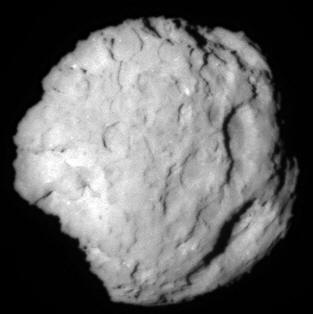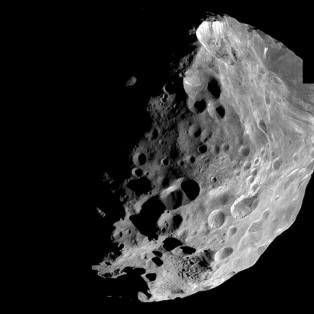|
 
The surface of Comet Wild 2 (left). Saturn's
moon Phoebe (right). Credit: NASA/JPL
Comet Crystals
Jul
29, 2010
Comets are said to be composed of
"dusty ices." Why have crystalline
structures that require high
temperatures been found in them?
NASA scientists
launched the Stardust mission on
February 7, 1999. Its primary task
was to collect dust particles from
the coma of comet Wild 2 and then
return to Earth. Fuel savings meant
that the capsule required a gravity
boost, so it returned to Earth orbit
from deep space after almost two
years of travel time. As it flew by
the home planet, it was accelerated
back out to its aphelion, 400
million kilometers from the Sun,
reaching a distance greater than any
other solar-powered spacecraft.
So that mission specialists could
test the camera operation and other
instrument packages, Stardust
briefly encountered the 4-kilometer
asteroid Annefrank on November
2, 2002 at a distance of 3000
kilometers while moving at 7
kilometers per second. Although the
dust collectors on board were open
to space, no material collection was
expected in the vicinity and none
was achieved.
After a five year journey, Stardust
finally intersected Wild 2's orbit
on January 2, 2004, passing through
its coma at the metaphorical hair's
breadth distance of 240 kilometers.
The
aerogel dust-capture system
worked perfectly, scooping up fine
bits of rock and trapping them
inside for their return journey to
Earth on January 15, 2006.
Although the spacecraft traveled
more than a billion kilometers over
a 7 year time span, the mothership
successfully released its payload
and the parachutes deployed,
cushioning the precious cargo for a
soft landing in the Utah desert. The
aerogel was delivered to a thrilled
team of researchers for analysis.
That's when the surprise and shock
began.
Minerals such as anorthite and
forsterite were found embedded in
the aerogel—compounds that form only
at extremely high temperatures—along
with olivine. Perplexed scientists
wondered how an object that was
supposed to be a remnant from the
early nebular cloud out of which the
Solar System condensed, and that
should have been kept in frozen
hibernation in a theoretical "Oort
cloud" billions of kilometers from
the Sun, could exhibit crystalline
structures that would require a
blast furnace to create.
Stardust mission team leader Donald
Brownlee said at the time, “In the
coldest part of the solar system
we’ve found samples that formed at
extremely high temperatures.”
Now, according to a
recent paper in the science
journal Nature, a mechanism
by which such high temperature
crystals might form has been
announced. A team led by Attila
Juhász from the
Max Planck Institute for Astronomy
examined the light emitted by EX
Lupi, thought to be a young star in
the constellation Lupus. EX Lupi is
a variable star, meaning it
periodically brightens over a
several month period. After one
energetic pulse in 2008, the
infrared
spectral signature of the star
seemed to indicate that some of the
orbiting dust had been changed from
a glasslike substance to one that is
similar to what was seen in the
spectrum of comet Wild 2: high
temperature crystals.
The unfortunate part of the
observation is the conclusion that
was reached. Among astrophysicists,
the consensus opinion is that stars
like EX Lupi undergo energetic
eruptions because they
gravitationally drag material from
their surroundings and accumulate it
on their surfaces. The added mass
compresses to the point where it
explodes in a thermonuclear reaction
and the stars "go nova." Note that
this is quite different from a
supernova explosion where a star
casts off its outer layers due to a
disruption in its hypothetical core
fusion reactions.
The supposed nova on EX Lupi is said
to have heated the glasslike matter
around the star until it became
"thermally annealed" and changed its
physical structure into harder
crystals like the forsterite
discovered in the coma of Wild 2. In
other words, it is the old standby
of gravity, heat, and shock waves
that are responsible for what is
observed.
Electric Universe advocates see
things differently. Stars and comets
share common characteristics because
they are both born of similar
parentage. Stars are nodes in vast
electrical circuits connected by
Birkeland current filaments within
galaxies. Planets, moons, asteroids,
and comets are electrically charged
and exist within a radial electric
current that surrounds stars like
our own Sun.
Comets, specifically, have nothing
to do with an ancient nebular cloud
of cold gas and dust that became
gravitationally unstable and
collapsed into the Solar System of
today. Comets and their asteroid
sisters are relative newcomers to
the solar family and might have been
blasted out of larger bodies by
tremendously powerful electric
discharges in the recent past. They
are not "snowballs" or blobs of
muddy slush, they are solid, rocky,
cratered, electrically charged
objects.
When Stardust arrived at Wild 2, it
found that the coma contained the
"signature" of water vapor, although
the distribution was anomalous. The
farther from the surface of the
comet, the greater the amount of
vapor, surely a result that is
diametrically opposed to the
theoretical model of sublimating
ices jetting out from the nucleus.
So what was the "water vapor?"
Whatever water or hydroxyl compounds
that can be found in cometary comas
is created there because ionized
oxygen from the comet reacts with
hydrogen ions streaming out from the
Sun. No "jets" of water vapor spew
from comets, and no icy plains have
ever been observed. It is electric
effects that are seen—discharges and
arcs form the comet phenomena.
Similarly, stars do not oscillate in
brightness or energy output because
they are accumulating excess mass.
They do so because they are
experiencing an increased electrical
input from the galaxy. The electric
current flowing into the star causes
it to change its discharge behavior.
It might go from a stable and (what
is for it) "normal" glow mode to a
more intense arc mode state. The
greater current flow might cause
z-pinch regions around the star
where its plasma could then be
reformed into different chemical
compounds. It is more likely that
processes involving plasma are
responsible for the changes in
stellar spectrograms.
So, in conclusion, the Sun and
comets are part of one electrically
active circuit that is occupied by
many different regions of charge
distribution. The Sun receives its
power from the protean electric
generator we call the Milky Way.
Accordingly, planets and other
bodies exist within a flow of
charged particles constantly
streaming from the Sun. As any first
year electrical engineering student
knows, a stream of charged particles
is an electric current.
Stephen Smith
|








